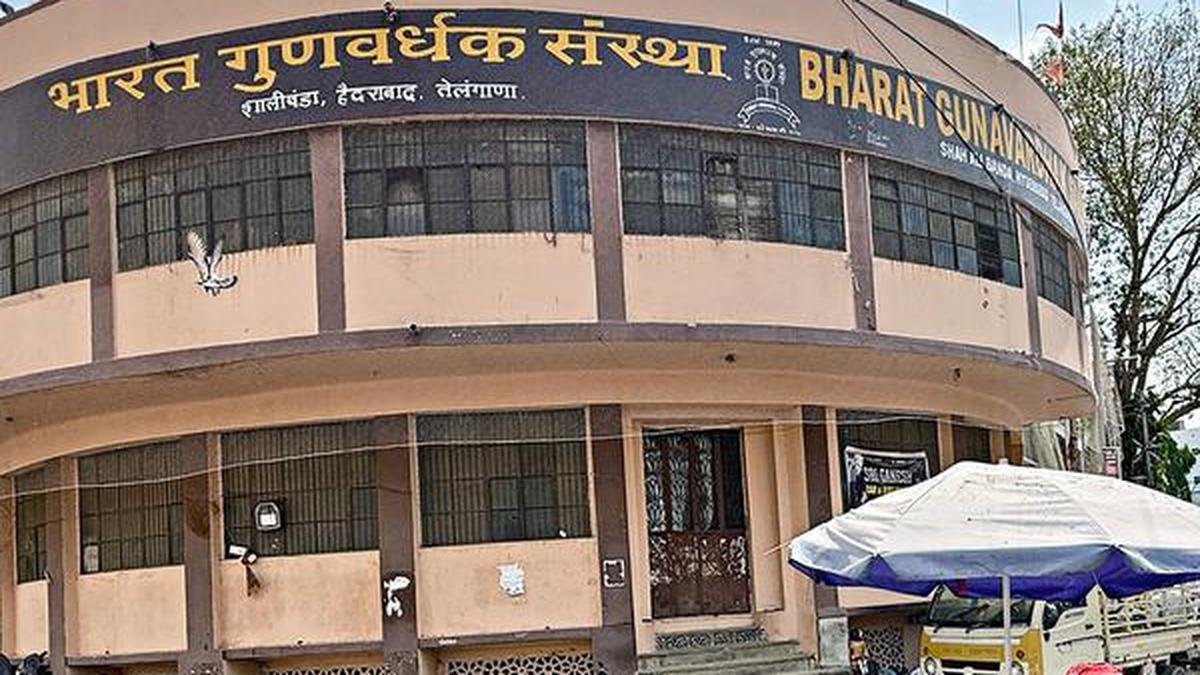It is a library with a difference. A large cool airy room for students and children preparing for competitive exams to sit down and read through the day. The difference lies beneath it in the bunker which is the genesis of Bharat Gunavardhak Sanstha library in Shalibanda. “It was built as an air raid shelter before the outbreak of hostilities during the Second World War. After the war, my father Rai Mahbub Narayan went around asking his friends who were leaving for Pakistant to leave the books with him. Every Hyderabadi had at that time had a library. Within no time, my father collected 50,000 books,” informs Oudesh Rani Bawa who grew up in Gowliguda area near Shahalibanda.
The air raid protection shelter that has been turned into a library in Shalibanda in Hyderabad.
| Photo Credit:
Serish Nanisetti
This collection of books led to the creation of a group of people who pooled their ideas and resources. “The library was named Bharat Gunavardhak Sanstha by polyglot scholar Gunde Rao Harkare. Mr. Harkare retired as a session judge of Wanaparthy and donated a copy of Sirr-e-Akbar, that is a translation of Upanishad from Sanskrit to Persian. As it was a priceless manuscript it was sent to Khuda Baksh Oriental Library in Patna,” informs Ms. Oudesh.
Engineer Malliah executed the project which was a two-storey structure on top of the bunker without taking any remuneration on a 471 square yard plot taken on a 100 year lease. It had two rooms for scholars, one room for a watchman, a stock room and a reading room.
The air raid protection shelter that has been turned into a library in Shalibanda in Hyderabad.
| Photo Credit:
Serish Nanisetti
Now, the air raid bunker has been turned into a storage room for chairs and tables. “We don’t have the stuff to run a separate newspaper section. The sanctioned staff strength is 14 but we have only two staffers,” informed an official of the library.
The dusty room with rows of chairs remains locked up. But it is a better fate than most other air raid shelters in Hyderabad that were built around that time. “The air raid shelter in the Bella Vista (Administrative Staff College of India) is still intact, as is the one in the premises of College of Community Science where it is camouflaged by a lone palm tree,” informs Anuradha Reddy of Indian National Trust for Art and Cultural Heritage.
In 1941, while the war in Europe was raging, there was a threat perception about India’s eastern coast. This led to the Nizam’s Public Works Department stepping in and building Air Raid Protection Shelters for the nobility. Five of them were built — one at the King Kothi Palace, another at Bella Vista, another one Hill Fort Palace, the residence of Nawab Basalat Jah Bahadur and one more at the security chamber at King Kothi Palace for Nizam Osman Ali Khan. While the Bella Vista air raid shelter has survived, the fate of others is not known.
Other noblemen also built air raid shelters for their own safety, including Salar Jung III. “It was there till early 60s and was to the right side of the entrance to the palace complex,” informs Ms. Oudesh. Nothing remains of it. One more air-raid bunker was built by Nasir Nawaz Jung of the Vicar-ul-Umra family on top of the Jubilee Hills property. “It is still there and is a shelter for roosting bats. We don’t try to enter that area,” says Raunaq Yar Jung, a descendant of Nasir Jung.
Published – May 10, 2025 10:02 am IST


























